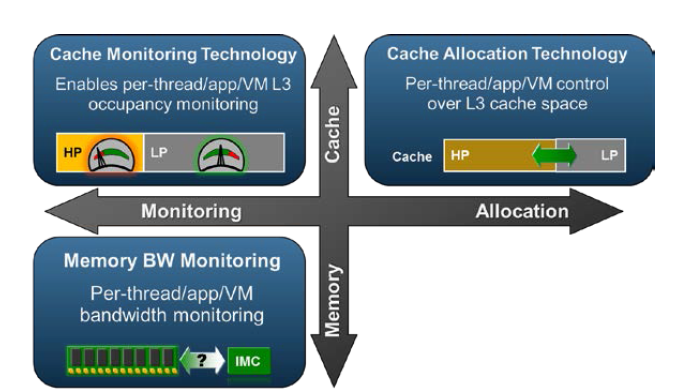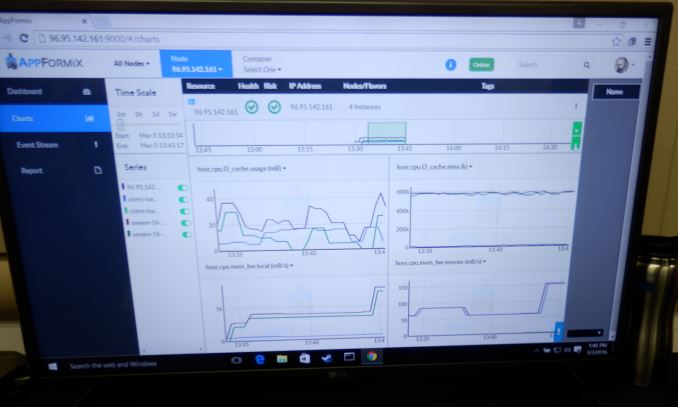The Intel Xeon E5 v4 Review: Testing Broadwell-EP With Demanding Server Workloads
by Johan De Gelas on March 31, 2016 12:30 PM EST- Posted in
- CPUs
- Intel
- Xeon
- Enterprise
- Enterprise CPUs
- Broadwell
Sharing Cache and Memory Resources
In a virtualized environment, the hosted VMs are sharing both the CPU caches and the overall DRAM memory bandwidth. One cache-hungry application can quickly hog most of the shared L3 caches, and a bandwidth intensive one can do the same with the available and shared memory bandwidth. These VMs create the "noisy neighbor" problem. That is bad news for anyone consolidating a lot of VMs on top of a Xeon server, but it is complete show stopper for telco and other scenarios where service providers want to guarantee "Quality-of-Service" (QoS) and thus predictable latency. For Intel this is a notable scenario to address, as the telco market is one of the few markets where the Xeons still have some room to grow. Many telco applications still run on proprietary boxes, which makes virtualization a tantalizing option if Intel can deliver the necessary latency.
Haswell had already some features to monitor cache usage, which in turn allowed you to identify the noisy neighbors. However the "Resource Director Technology" (RDT) of Broadwell can do a lot more.
RDT can not only monitor L3 cache usage and memory bandwidth, but it can also allocate L3-cache space on a per thread/process/virtual machine basis. Threads are assigned a Resource Monitoring ID. Eight of these RMID are available per core/cache slice. Sixteen different classes of service can be assigned to an RMID: higher priority threads/applications can get a higher class, and thus a larger portion of the L3-cache.
Intel has already demonstrated an application that made use of these new MSRs to read out memory bandwidth and L3 cache consumption on different levels.












112 Comments
View All Comments
SkipPerk - Friday, April 8, 2016 - link
"Anyone putting Microsoft on bare hardware these days is nuts"This brother is speakin the truth!
warreo - Thursday, March 31, 2016 - link
Can someone clarify this line for me?"The average performance increase versus the Xeon E5-2690 is 3%, and the Broadwell cores get a boost of no less than 19%."
Does that mean IPC increase is 19% for Broadwell, offset by ~16% decline in clockspeed to get to 3% average performance increase? But that doesn't make sense to me as a 3.8ghz (E5-2690) to 3.6ghz (E5-2699 v4) is only 5% decline in max clockspeed?
ShieTar - Thursday, March 31, 2016 - link
I understood it as "the -Ofast setting boosts Broadwell by 19%", so with the -O2 setting it was actually 16% slower than the 2690.And I think the AT-Theory based on the original measurements is that the 3.6GHz boost are not even held for a significant amount of time, so that Broadwell in reality comes with an even worse decline in clock speed.
warreo - Thursday, March 31, 2016 - link
Your interpretation makes much more sense than mine, but still doesn't quite add up. The improvement from using -Ofast vs. -O2 is 13% on average, and the lowest improvement is 4% on the xalancbmk, well below the "no less than 19%" quoted by Johan.Perhaps the rest of the disparity is normalizing for sustained clock speeds as you suspect? Johan is that correct?
Ryan Smith - Thursday, March 31, 2016 - link
I've reworded that passage to make it clearer. But ShieTar's interpretation was basically correct."Switching from -O2 to -Ofast improves Broadwell-EP's absolute performance by over 19%. Meanwhile the relative performance advantage versus the Xeon E5-2690 averages 3%. "
JohanAnandtech - Thursday, March 31, 2016 - link
That means that the -ofast has much more effect on the Broadwell. I mean by that that -ofast is 19% faster than -o2 on Broadwell, while it is 3% faster on Sandy Bridge. I assume that the older the architecture, the better the compiler is able to optimize it without special tricks.warreo - Friday, April 1, 2016 - link
Thanks for the clarification. Loved the review, great work Johan!Pinn - Thursday, March 31, 2016 - link
I'm still happy I went with the 6 core x99 over the 8 core. Massive core count is nice to see available, but I don't see the true value. Looks like you have to do the same rough math to see if the clock speed reduction is worth the core count.Oxford Guy - Tuesday, April 5, 2016 - link
Why would there be "true value" for six and not for eight?Pinn - Wednesday, April 6, 2016 - link
Single threaded workloads.